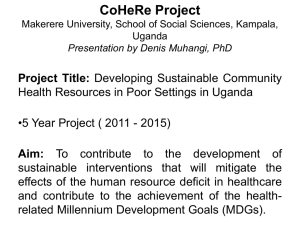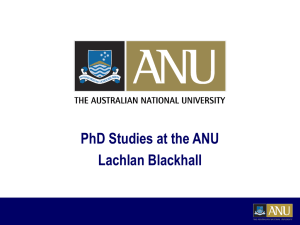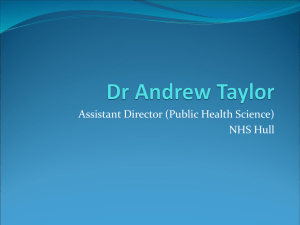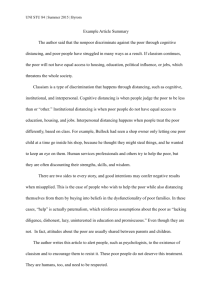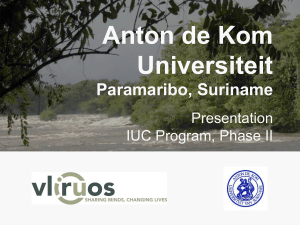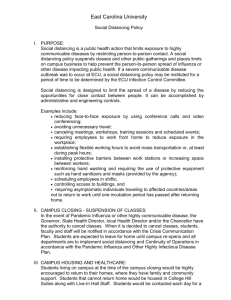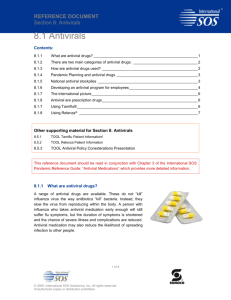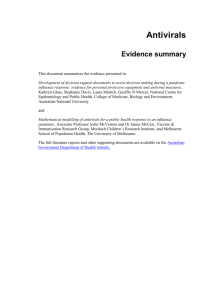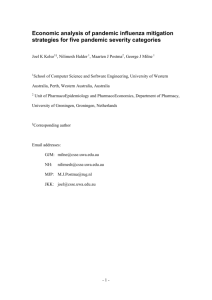Slide show - Department of Health and Human Resources
advertisement
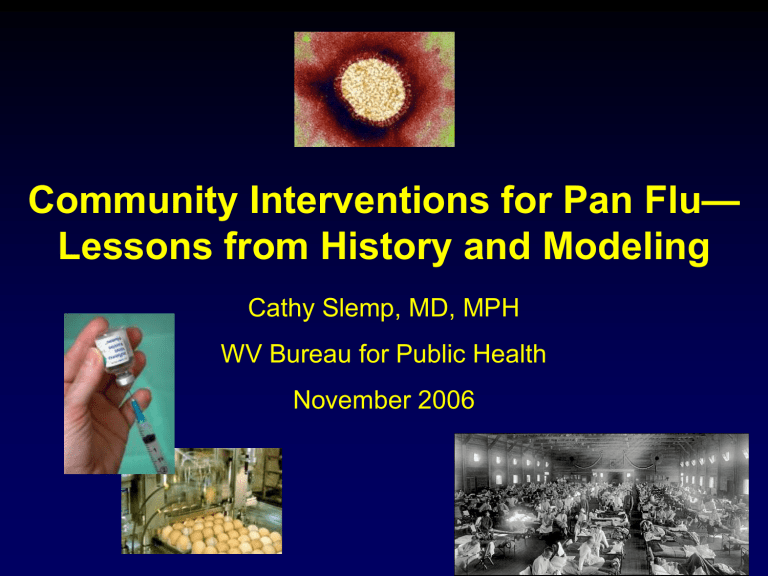
Community Interventions for Pan Flu— Lessons from History and Modeling Cathy Slemp, MD, MPH WV Bureau for Public Health November 2006 Influenza Pandemic Viruses Requirements: – A new influenza A subtype that can infect humans AND – Causes serious illness AND – Spreads easily from human-to-human H5N1 meets the first two prerequisites, but not the last Next pandemic virus may or may not be due to a variation of current H5N1 virus Update: H5N1 in Humans – 2003-2006 • As of October 31, 2006: 256 cases, 152 deaths (~60%) – Ten countries • Sporadic, with occasional clusters • Most had close contact with sick poultry • Few cases of probable, limited human-to-human transmission • All lived in countries with poultry outbreaks Update As of 10/31/06: 256 cases; 152 deaths; most poultry related Flu Pandemics Happen. (10 in last 300 years) Impacts of Past Pandemics Pandemic Deaths in the US Deaths Worldwide Population Affected Spanish Flu (H1N1) 1918-1919 500,000 40 million Persons 20-40 years old Asian Flu (H2N2) 1957-58 70,000 1-2 million Infants, elderly Hong Kong Flu (H3N2) 1968-69 36,000 700,000 Infants, elderly IMPACT CAN BE DRAMATIC Daily Deaths in Ohio - 1918 Brodrick OL. Influenza and pneumonia deaths in Ohio in October and November, 1918. The Ohio Public Health Journal 1919;10:70-72. Sample Estimate of Pandemic Morbidity/Mortality, West Virginia* • • • • • • • Characteristic Moderate (1957-68-like) Severe (1918-like) Illness 540,000 (30%) 540,000 (30%) Outpatient 270,000 (50%) 270,000 (50%) Hospitalization 5,314 60,813 ICU Care 791 9,123 Ventilators 399 4,558 Deaths 1,284 11,690 * Based upon DHHS U.S. estimates applied to WV population numbers. These are in the absence of potential interventions. What we don’t know … about the next pandemic • When will it occur? • Which virus will cause it, H5N1 or another? • Who will be most at risk (Elderly and infants? Other?) • How severe an illness will it cause? • Will there be multiple waves? • Will antiviral medication work? • How long until we have a vaccine? • What are the best control measures? Planning Pandemic Control Measures Community-Based Interventions 1. Delay outbreak peak 2. Decompress peak burden on hospitals / infrastructure 3. Diminish overall cases and health impacts #1 Pandemic outbreak: No intervention #2 Daily Cases Pandemic outbreak: With intervention #3 Days since First Case What can we learn from historical analysis? Excess Mortality / 100,000 Population Cumulative Excess Mortality by Location in 1918 1000 900 800 700 600 500 400 300 200 100 0 0 10 20 30 40 Location McLaughlin AJ. Epidemiology and Etiology of Influenza. Boston Medical and Surgical Journal, July 1920. Deaths Rates / 100,000 Population (Annual Basis) 1918 Death Rates: Philadelphia v St. Louis 16000 Philadelphia St. Louis 14000 12000 10000 8000 6000 4000 2000 0 22 /22 /22 /22 /22 /22 /22 /22 /22 /22 /22 /22 /22 /22 /22 /22 / 15 /22 /29 0/6 /13 /20 /27 1/3 /10 /17 /24 2/1 2/8 /15 /22 /29 / 1 9 9 9 1 1 1 11 11 11 10 10 10 12 12 12 Date Weekly mortality data provided by Marc Lipsitch (personal communication) Date 12 /2 8 /1 8 /1 8 140 /2 1 /1 8 160 12 /1 8 /1 8 /1 8 /7 /1 8 /1 4 12 /3 0 /2 3 /1 6 /9 /1 8 Wash DC Seattle 11 11 11 11 /1 8 /1 8 /1 8 /2 /1 8 /2 6 /1 9 /1 2 Deaths / 100,000 Population 100 Peak 147 52 12 /1 8 /1 8 /1 8 /5 /1 8 11 10 10 10 10 9/ 28 9/ 21 9/ 14 Washington DC v Seattle Seattle Washington, DC 120 Aggregate (1918) 550 335 80 60 40 20 0 Thinking Through Control Measures Influenza Transmission Facemasks, cough etiquette Viruses: Cleaning, handwashing Leave original host Survive in transit Social distance, cohorting Facemasks, handwashing Vaccination Delivered to a susceptible host Reach a susceptible part of the host Escape host defenses Multiply and cause illness Potential Tools in Our Toolbox • Our best countermeasure – vaccine – will probably be unavailable during the first wave of a pandemic • Antiviral treatment may improve outcomes but will have only modest effects on transmission • Antiviral prophylaxis may have more substantial effects on reducing transmission • Infection control and social distancing should reduce transmission, but strategy requires clarification Ro R0 = 12 Effect of Increasing Social Distance on Epidemic Dynamics Exponentiation Suppression Ro = 2.0, Ro = 0.67, Progression = 1:2:4:8:16 Progression = 1:2:4:3:2 Increasing “Social Distance” “Community Shielding” Measures Close or alter high risk transmission environments e.g. schools, daycare centers if supported by epidemiology Cancel large public gatherings (concerts, theaters) Minimize other exposures (market, church, public transit) Encourage ill and exposed to stay home (I & Q) Worksite adaptations (e.g., telecommuting, etc.) Scaling back transport services (holiday schedule) Consider additional community measures COOP to minimize economic impact Surgical masks, barrier precautions, hand hygiene What Does Disease Modeling Suggest? Examining the Potential of Combined Interventions %Population Infected 80% 70% 60% 50% 40% 30% 20% QP Q,T PT P T Q None N on e Sc ho ol Ki ds Sc Ad ho ul ts ol ,A du Ki ds l ts ,A du Sc Sc l ts ho ho ol ol , ,K Ki id ds s, A du lts 0% Q,P,T 10% Value of combining strategies – Longini model 70 60 50 40 30 20 10 0 Clinical attack rate Antiviral stockpile needed Base case (Ro=1.9) Generic social distancing School closure School closure + generic social distancing 60% Case treatment + 60% household prophylaxis 60% Case treatment + 60% household prophylaxis + 60% social prophylaxis (60% TAP) 60% TAP + School closure + generic social distancing Conclusions • Models suggest that partially effective interventions, when used in a layered manner, may be highly effective in controlling the spread of influenza in a community. • Mitigation strategies appear to be most effective when implemented in a uniform manner early in an outbreak. • When used as part of a layered strategy, models suggest that social distancing measures can have a significant impact on disease transmission, even if one assumes low rates of compliance and effectiveness. What are limits of this data? • Observational data from 1918; data incomplete; cannot link cause and effect • Modeling impact of interventions useful, but – Doesn’t yet incorporate people’s behavioral responses to flu itself or to our interventions – Doesn’t incorporate secondary consequences of interventions (e.g., effects of school closure on education, workforce, etc.) • Does help shape discussion. Community Mitigation Strategies Carry Consequences That Should Be Anticipated and Incorporated into Pandemic Planning • Economic impact and potential disruption of services due to absenteeism • Issues associated with sequestration of children • Home-based care • Disproportionate impact on certain populations • Administration of antiviral medications – As treatment without rapid diagnostics – As prophylaxis to household contacts of ill persons These and other consequences may occur in the absence of community-wide interventions, as a result of spontaneous action by the public. Residences Workplace / Classroom Social Density Offices Hospitals 7.8 feet Elementary Schools 11.7 feet 16.2 feet 3.9 feet http://buildingsdatabook.eren.doe.gov/docs/7.4.4.xls Spacing of people: If homes were like schools *Based on avg. 2,600 sq. ft. per single family home Spacing of people: If homes were like schools *Based on avg. 2,600 sq. ft. per single family home Households in the United States Single adult (no children) 2 or more adults (no children) 35.4% Tw o parents w ith children<18 Single parent w ith children<18 37 million 26.6% 28 million 12 million 28 million 26.3% 11.7% Source: U.S. Census Bureau, Population Division, Current Population Survey, 2003 Annual Social and Economic Supplement http://www.census.gov/population/www/socdemo/hh-fam/cps2003.html Labor Status of Parents Households with no children<18 Households with children>12 Households with children<12 and non-working adult Working couple with children<12 62.0% Single working parent with children<12 66 million 18 million 5 million 8 million 9 million 16.6% 4.5% 8.0% 8.9% Source: U.S. Census Bureau, Population Division, Current Population Survey, 2003 Annual Social and Economic Supplement http://www.census.gov/population/www/socdemo/hh-fam/cps2003.html Macroeconomic Analysis • Preliminary macroeconomic analyses of the impact of community-wide interventions have been performed, using several economic models • These models predict supply-side impacts that range from a decrease in overall economic impact as a result of community-wide interventions, to a modest increase in impact • These estimates do not incorporate the costs associated with lives lost during a severe pandemic • If an economic value is assigned to lives lost during a severe pandemic, community-wide interventions result in a 5-10 fold decrease in overall cost A Targeted and Layered Approach So, Recent Analyses Suggest That Community Actions May Significantly Reduce Illness and Death Before Vaccine is Available Early and uniform implementation of such measures as: • • • • School closure Keeping kids and teens at home Social distancing at work and in the community Encouraging voluntary home isolation by ill individuals and voluntary home quarantine by their household contacts • Treating the ill and providing targeted antiviral prophylaxis to household contacts • Implementing measures early and in a coordinated way A Layered Approach Individual / Household / Agency Community Isolation of ill Hand hygiene Treatment of ill Cough etiquette Quarantine of exposed Infection control Prophylaxis of exposed Living space control School closure Isolation of ill Protective sequestration Designated care provider of children Facemasks Social distancing - Community - Workplace Liberal leave policies International Containment-at-source Support efforts to reduce transmission Travel advisories Layered screening of travelers Health advisories Limited points of entry Epidemiology Drives Approach (Targeted) Mild Moderate Severe Case Fatality Rate ≤ 0.1% 0.1 - 0.5% ≥ 0.5% Isolation Yes Yes Yes Treatment Yes Yes Yes Quarantine No ??? Yes Prophylaxis High-risk individuals High-risk individuals Yes School Closure Reactive Punctuated ??? Proactive Protective sequestration High-risk individuals High-risk individuals Children Community social distancing High-risk individuals Encouraged Encouraged + selective closures Workplace protections Encourage good hygiene Social distancing Aggressive social distancing Liberal leave policies Confirmed influenza Influenza-like illness ILI and/or sick family members Things to consider in choosing strategies • Disease severity • Information on the disease (e.g., are there high risk subgroups? How effective are antivirals? etc.) • Ability to practically implement the control measure • Public acceptability of the control measure • Secondary impacts of the measure—are we doing more harm than good? • What should be implemented by communities and what centrally? Is a common approach important? • Ethical considerations What Can Communities Do Now? • Education of leadership about the need for cross-sectoral planning • Engagement of non-health communities: education, private sector, labor, faith communities, NGO’s, the public • Development of Community-wide plans • Scenario-based discussions of implementation • Plan how to support and protect staff What does this take? (Now and when the time comes) Leadership Imagination Resiliency of Individuals, Agencies, and Communities Contributors to Historical Analysis and Modeling HSC/NSPI Writing Team Richard Hatchett, MD Carter Mecher, MD Laura McClure, MS CDR Michael Vineyard HSC Rajeev Venkayya, MD Ken Staley, MD, MPA NSC Rita DiCasagrande, MS CEA Steven Braun, PhD CDC David Bell, MD Martin Cetron, MD Rachel Eidex, MD Lisa Koonin, MN, MPH Anthony Marfin, MD Modelers Joshua Epstein, PhD Stephen Eubank, PhD Neil Ferguson, PhD Robert Glass, PhD Betz Halloran, PhD Nathaniel Hupert, MD Marc Lipsitch, MD Ira Longini, PhD NIH James Anderson, PhD Irene Eckstrand, PhD Peter Highnam, PhD Ellis McKenzie, PhD RTI Philip Cooley, PhD Diane Wagener, PhD NVPO Bruce Gellin, MD Ben Schwartz, MD Department of Education Camille Welborn, MS Department of Labor Suey Howe, JD Department of the Treasury Nada Eissa, PhD Chris Soares, PhD John Worth, PhD Department of Finance Canada Steven James Timothy Sargent University of Michigan Howard Markel, MD Get Informed, Be Prepared! RESOURCES WVBPH: Div Threat Prep or DSDC Your Emergency Management Agency and Local Health Department http://www.wvflu.org http://www.pandemicflu.gov ASTHO (www.astho.org) and NACCHO (www.naccho.org) Websites CDC website (www.cdc.gov)

